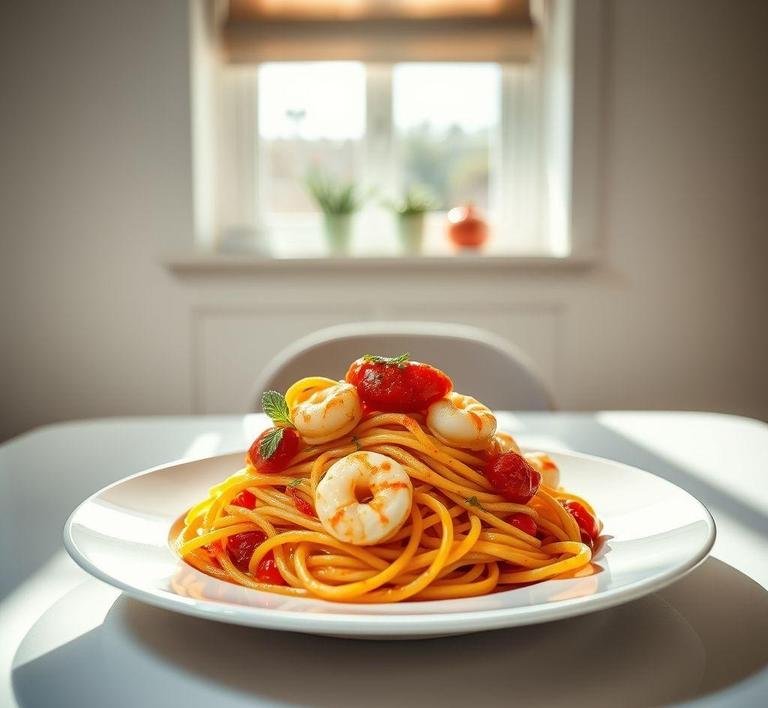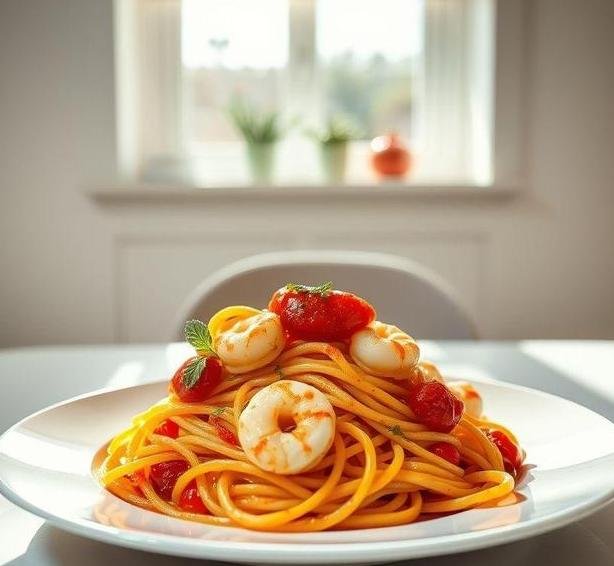Mary Berry’s Seafood Linguine with Fresh Tomato Sauce is a delightful and vibrant dish that combines the delicate flavors of fresh seafood with a rich, homemade tomato sauce. Known for her mastery in the kitchen, Mary Berry has designed this dish to be both simple and elegant, making it the perfect option for any occasion, whether it’s a weeknight dinner or a dinner party.
The dish centers on linguine, a type of long, flat pasta, which serves as the ideal vehicle for the rich seafood and savory tomato sauce. The seafood component often includes a variety of oceanic treasures-such as prawns, mussels, and white fish-which add a depth of flavor and texture. The fresh tomato sauce is made from ripe, juicy tomatoes that offer a natural sweetness, balanced by aromatic garlic, fresh herbs, and a dash of seasoning to enhance the overall taste.
It’s a dish that harmonizes freshness with comfort, offering a light yet satisfying meal that transports your senses straight to the Mediterranean coast. The careful balance of flavors, along with the quick cooking time, makes it a recipe anyone can easily master, even if they’re not a seasoned chef.
Mary Berry’s Seafood Linguine With Fresh Tomato Sauce Recipe
Ingredients Needed

To make Mary Berry’s Seafood Linguine with Fresh Tomato Sauce, you’ll need the following ingredients:
- Linguine: About 250g of linguine pasta, which should be cooked al dente to achieve the best texture and absorb the sauce well.
- Seafood Mix: A combination of fresh seafood, typically including prawns, squid, and mussels (or any combination of seafood you prefer). Aim for about 300g of seafood.
- Fresh Tomatoes: 4-5 medium-sized, ripe tomatoes. These are the base of your sauce and provide the natural sweetness and acidity needed for balance.
- Garlic: 2-3 cloves, finely chopped. Garlic adds a deep aromatic layer that infuses the sauce with warmth.
- Olive Oil: For sautéing and for drizzling over the dish. Extra virgin olive oil will bring in a subtle fruity flavor.
- Shallots: 1 or 2 shallots, finely diced. Shallots are milder than onions and add a gentle sweetness to the sauce.
- Fresh Herbs: A handful of fresh basil or parsley, finely chopped. This adds a burst of fresh, herbal notes that perfectly complement the seafood.
- White Wine: A splash (about 100ml) of dry white wine to deglaze the pan and elevate the flavor profile of the sauce.
- Lemon: Zest and juice of half a lemon for a bright, citrusy finish that balances the richness of the seafood and tomato.
- Salt and Pepper: To season the sauce and seafood, ensuring every element is well-seasoned.
- Chili Flakes (optional): If you like a bit of heat, a pinch of chili flakes can be added to the sauce to enhance its flavor.
- Parmesan Cheese (optional): For a finishing touch, a light dusting of freshly grated Parmesan can be added just before serving.
Equipment Needed
While the recipe is straightforward, having the right kitchen tools will ensure everything runs smoothly. Here’s what you’ll need:
- Large Pot: For cooking the linguine. A big pot ensures the pasta can move freely as it cooks, preventing it from sticking together.
- Large Frying Pan or Sauté Pan: For making the tomato sauce and cooking the seafood. A wide pan helps distribute heat evenly and allows you to sauté the garlic, shallots, and seafood without overcrowding.
- Knife and Chopping Board: For chopping the garlic, shallots, herbs, and tomatoes. A sharp knife will make your prep work quick and easy.
- Colander: To drain the cooked pasta.
- Ladles or Tongs: To serve the pasta and seafood together. These help combine the elements without breaking up the delicate seafood.
- Grater or Zester: For zesting the lemon and grating Parmesan if you’re using it as a topping.
- Measuring Cups or Jugs: To measure out the wine, oil, and lemon juice for precision.
- Wooden Spoon: For stirring the sauce and ensuring that the ingredients meld together beautifully.
Instructions To Make Mary Berry’s Seafood Linguine With Fresh Tomato Sauce
- Cook the Linguine: Start by boiling a large pot of salted water. Add the linguine and cook according to the package instructions, typically around 8-10 minutes, until al dente. Once cooked, drain and set aside, reserving a cup of pasta water in case the sauce needs to be thinned out later.
- Prepare the Tomato Sauce: In a large frying pan or sauté pan, heat the olive oil over medium heat. Add the chopped garlic and shallots, and sauté for 2-3 minutes until they become soft and aromatic.
- Add the Tomatoes: Dice the fresh tomatoes and add them to the pan. Stir them around and cook for 5-7 minutes, letting the tomatoes break down and release their juices. Season the sauce with salt, pepper, and a pinch of chili flakes if using. Add the white wine and allow it to reduce slightly.
- Cook the Seafood: While the tomato sauce is simmering, add the seafood mix to the pan, along with a splash of lemon juice. Stir gently and cook for about 5-7 minutes, or until the seafood is just cooked through (prawns should be pink, and mussels should open up). Be sure not to overcook the seafood to maintain its tenderness.
- Combine the Pasta and Sauce: Once the seafood is ready, add the cooked linguine to the pan with the tomato sauce. Toss gently to coat the pasta evenly in the sauce. If the mixture looks too dry, add a splash of the reserved pasta water to loosen it up and achieve a silky texture.
- Finish with Fresh Herbs: Stir in the fresh basil or parsley, and adjust the seasoning with more salt, pepper, or lemon juice as needed. Serve the linguine hot, garnished with extra fresh herbs and a sprinkle of Parmesan cheese, if desired.
Tips And Tricks
- Pasta Texture: To ensure your linguine doesn’t become overcooked and mushy, be sure to drain it a minute before it reaches the al dente stage. The pasta will continue to cook when mixed with the hot sauce.
- Seafood Variety: While prawns, squid, and mussels work wonderfully, feel free to experiment with different types of seafood based on what’s available. Clams, scallops, or even a bit of lobster can elevate the dish further.
- Tomato Quality: Fresh tomatoes are key to this recipe. If tomatoes are not in season, you can use canned tomatoes, but opt for high-quality, whole tomatoes for the best flavor.
- Wine Selection: A dry white wine such as Sauvignon Blanc or Pinot Grigio works best for this dish. Avoid sweet wines, as they can alter the balance of flavors in the sauce.
- Make-Ahead Option: The seafood and tomato sauce can be prepared a few hours in advance, allowing the flavors to meld together. Just reheat the sauce gently before adding the pasta and seafood.
- Don’t Overcook the Seafood: Seafood can easily become rubbery when overcooked, so keep a close eye on it. Once the prawns turn pink and the mussels open, it’s ready to go.
Mary Berry’s Seafood Linguine with Fresh Tomato Sauce is a dish that blends simplicity with elegance. The fresh, sweet tomatoes paired with tender seafood and perfectly cooked linguine create a harmonious and satisfying meal. Whether you’re a novice in the kitchen or an experienced cook, this recipe is easy to follow and delivers a restaurant-quality dish right at home.
The beauty of this recipe lies in its versatility, allowing you to tailor the seafood mix to your preferences while still maintaining the essential flavors that make this dish so special. Fresh herbs, citrus, and a touch of white wine elevate the flavors, making every bite a delightful experience. So, whether you’re serving it to guests or enjoying it on your own, Mary Berry’s seafood linguine promises a refreshing and comforting meal that will always leave you wanting more.
Easy Recipe Variations For Mary Berry’s Seafood Linguine With Fresh Tomato Sauce

Mary Berry’s Seafood Linguine with Fresh Tomato Sauce is a delightful, fresh, and flavorful dish that has become a staple in many households. However, one of the beauties of this recipe is how easily it can be adapted to suit different tastes and dietary preferences. Here are a few easy variations to make the dish your own:
1. Swap the Seafood for Other Protein Options:
While the original recipe features a mix of shellfish like prawns, mussels, and scallops, you can switch up the seafood based on your preferences or availability. For instance, grilled chicken or white fish fillets such as cod or haddock can be used as an alternative. If you’re looking for a vegetarian version, consider using sautéed mushrooms, zucchini, or even tofu for a meatless yet hearty substitute.
2. Add a Little Spice:
For those who enjoy a kick of heat, consider adding red pepper flakes, chopped fresh chilies, or even a pinch of smoked paprika to the tomato sauce. This will elevate the dish, giving it an exciting layer of flavor. You can also mix in some chili oil for a fragrant, spicy drizzle before serving.
3. Change Up the Pasta:
Although linguine works beautifully in this dish, you can easily switch to other pasta shapes depending on your mood or what you have on hand. Spaghetti, fettuccine, or pappardelle would work equally well. For a gluten-free variation, try gluten-free pasta or even spiralized zucchini or sweet potatoes for a lighter, carb-conscious option.
4. Experiment with Herbs:
The fresh tomato sauce in Mary Berry’s recipe calls for basil, which complements the seafood beautifully. But don’t be afraid to experiment with other herbs. Fresh parsley, dill, or even tarragon can be excellent alternatives to bring out new flavors. A bit of lemon thyme could also provide an interesting citrusy depth to the sauce.
5. Make It Richer or Lighter:
If you want to make the dish richer, consider adding a splash of cream or a dollop of mascarpone to the tomato sauce. This will give the sauce a velvety texture, balancing the acidity of the tomatoes with creaminess. For a lighter alternative, skip the cream and add a little extra lemon juice or white wine to enhance the brightness of the sauce.
6. Add Vegetables for Extra Nutrition:
Mary Berry’s recipe already includes a simple fresh tomato sauce, but you can add even more vegetables to boost the nutritional profile. Bell peppers, spinach, cherry tomatoes, or roasted eggplant can all complement the flavors while adding texture and nutrients. Try sautéing the vegetables first before adding them to the sauce to intensify their flavor.
Storing Leftovers
If you’ve made a larger batch of Mary Berry’s Seafood Linguine with Fresh Tomato Sauce and find yourself with leftovers, storing them properly is essential to preserve the flavors and maintain freshness. Here’s how to store it for maximum shelf life:
1. Refrigeration:
Once your linguine has cooled to room temperature, place it in an airtight container to prevent it from drying out. The seafood and fresh tomato sauce will keep well in the fridge for up to 2-3 days. However, it’s important to note that seafood doesn’t keep as well as other proteins, so be sure to consume it within this time frame for the best taste and texture.
2. Freezing:
While freezing seafood pasta dishes is generally not recommended due to the delicate nature of seafood, you can freeze the tomato sauce separately for longer storage. If you decide to freeze the entire dish, it’s best to omit any cream or dairy, as they can break down and change in texture during freezing. Allow the dish to cool completely before transferring it into freezer-safe bags or containers. It will last up to 2 months in the freezer. When you’re ready to enjoy it again, defrost it in the fridge overnight and reheat gently on the stovetop.
3. Reheating:
When reheating leftovers, it’s best to do so slowly and gently to avoid overcooking the seafood or drying out the pasta. Reheat in a pan over low heat, adding a little bit of water or stock to keep the sauce from thickening too much. If reheating in the microwave, cover the dish with a damp paper towel to trap moisture, and heat in short intervals to ensure even heating.
What To Eat With Mary Berry’s Seafood Linguine With Fresh Tomato Sauce?
The light and fresh nature of Mary Berry’s Seafood Linguine with Fresh Tomato Sauce makes it a versatile main course that pairs beautifully with a variety of side dishes. Whether you’re hosting a dinner party or enjoying a simple family meal, here are some fantastic side options to consider:
1. Garlic Bread or Focaccia:
What could be better than a warm slice of garlic bread or a piece of soft, herb-infused focaccia to mop up any extra sauce? The buttery, garlicky flavor pairs perfectly with the freshness of the seafood and the tangy tomato sauce. If you want something a little healthier, you could opt for whole-grain bread or a simple crusty baguette.
2. A Light Salad:
Since the pasta is rich in flavors, a simple, crisp salad provides a nice contrast without overwhelming the dish. A classic Mediterranean-style salad with mixed greens, cherry tomatoes, cucumber, red onions, Kalamata olives, and feta cheese would complement the seafood linguine beautifully. The tangy vinaigrette adds a zesty kick, enhancing the freshness of the seafood.
3. Roasted Vegetables:
To add more texture and flavor, roasted vegetables like asparagus, zucchini, or cherry tomatoes can pair wonderfully with this seafood dish. The caramelization from roasting enhances the natural sweetness of the vegetables, which balances the acidity of the tomato sauce. Plus, the vegetables add extra nutrients, making your meal more satisfying.
4. Steamed Asparagus or Broccoli:
If you’re looking for a healthy and light side dish, steamed asparagus or broccoli works excellently with linguine. Their subtle bitterness and crunchy texture provide a nice contrast to the creamy, rich seafood pasta. You can also drizzle a bit of olive oil and squeeze some fresh lemon juice for added flavor.
5. A Glass of White Wine:
No Italian-inspired dish is complete without a glass of wine to wash it down. A crisp, dry white wine like Sauvignon Blanc, Pinot Grigio, or Vermentino pairs beautifully with the freshness of the seafood and tomato sauce. A light rosé could also work well if you prefer something with a little more fruitiness.
Conclusion
Mary Berry’s Seafood Linguine with Fresh Tomato Sauce is a dish that combines the best of Italian flavors with a touch of sophistication. Its simplicity makes it accessible for both novice cooks and seasoned chefs, while its versatility allows for countless variations based on personal preferences or dietary restrictions. The fresh tomato sauce, paired with succulent seafood and delicate pasta, provides a meal that’s both light and satisfying.
Whether you enjoy it as written or decide to make some creative tweaks, the recipe is a fantastic foundation for a variety of meals. When storing leftovers, always ensure proper refrigeration or freezing techniques to maintain the dish’s quality. And don’t forget the sides! Pairing the linguine with a crisp salad, garlic bread, or roasted vegetables will elevate your meal into an unforgettable dining experience.
FAQs
What Seafood Is Best For Mary Berry’s Seafood Linguine With Fresh Tomato Sauce?
Mary Berry’s seafood linguine recipe pairs beautifully with a mix of seafood such as prawns, mussels, and scallops. You can also add squid or any white fish like cod or haddock. The variety provides a range of textures and flavors that complement the fresh tomato sauce. For a more budget-friendly option, using frozen seafood can work as well, though fresh will elevate the dish.
Can I Make Mary Berry’s Seafood Linguine Ahead Of Time?
Yes, you can prepare elements of the dish ahead of time. You can cook the seafood and store it separately from the sauce in the fridge for up to a day. However, it’s best to cook the linguine fresh to maintain its texture. When ready to serve, simply reheat the seafood and sauce gently, and combine them with the pasta. This method will help preserve the flavor and quality.
What Should I Serve With Mary Berry’s Seafood Linguine?
Mary Berry’s seafood linguine with fresh tomato sauce is a light but flavorful dish, so pairing it with something simple is ideal. A crisp green salad with a lemon vinaigrette or a side of garlic bread would complement the meal well. You could also serve it with a glass of white wine, such as a crisp Sauvignon Blanc or a light Pinot Grigio, to enhance the seafood flavors.


